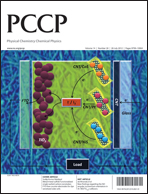The fragmentation process of the uracil RNA base has been investigated via DFT calculations in order to assign fragments to the ionisation mass spectrum obtained after dissociation induced by collision experiments. The analysis of the electronic distribution and geometry parameters of the cation allows selection of several bonds that may be cleaved and lead to the formation of various fragments. Differences are observed in the electronic behaviour of the bond breaking as well as the energy required for the cleavage. It is reported that N3–C4 and N1–C2 bonds are more easily cleaved than the C5–C6 bond, since the corresponding energy barriers amount to ΔG = +1.627, +1.710, +5.459 eV, respectively, which makes the C5–C6 bond cleavage almost prohibited. Among all possible formed fragments, the formation of the OCN+ fragment for the peak at m/z = 42 Da is excluded because of an intermediate that was not observed experimentally and too a large free energy barrier. Based on the required free energy, it is observed that two fragment derivatives: C2H4N+ and C2H2O˙+ may be formed, with a small preference for C2H4N+. This latter product is not formed through a retro Diels Alder reaction in contrast to C2H2O˙+. The following sequence is proposed for the peak at 42 Da: C2H4N+ (from N1–C2, C4–C5 cleavages) > C2H2O˙+ (from N3–C4, N1–C2 and C5–C6 cleavages) > C2H4N+ (from N1–C2, N3–C4 and C4–C5) > C2H2O˙+ (from C5–C6, N1–C2 and N3–C4 cleavages) > NCO+ (from N1–C2, C4–C5 and N3–C4 cleavages). Finally the peak at 28 Da is assigned to CNH2+ derivatives that can be formed through two different paths, the easiest one requiring 5.4 eV.

You have access to this article
 Please wait while we load your content...
Something went wrong. Try again?
Please wait while we load your content...
Something went wrong. Try again?


 Please wait while we load your content...
Please wait while we load your content...